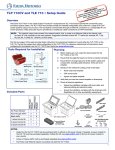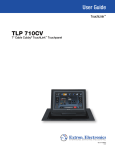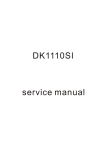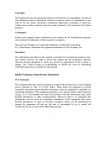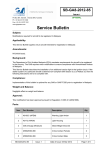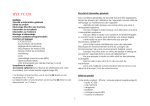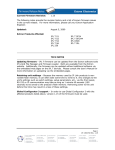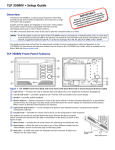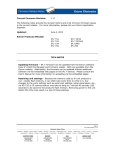Download Extron electronics TLP 710CV Setup guide
Transcript
Product Category T: TAoNn.com rfogruide R O IMP .extr use t TLP 710CV • Setup Guide ww 0CV produc r to w P 71 e Refe plete TL cting th urce. e o m n s o n r c o the efore c e powe b to th Overview The Extron TLP 710CV 7-inch Cable Cubby® TouchLink™ touchpanel provides AV connectivity using convenient pullout cables. It also provides simple and versatile configuration and control for a range of IP Link® control systems using a touch screen. The touchpanel communicates through an Ethernet connection to a configurable IP Link control processor. Video and audio input is provided by a twisted pair cable connected to an MTP transmitter. NOTE: The network output must be connected to a network switch, hub, or router that is connected to an Ethernet LAN or the Internet. An Extron IP Link controller must also be connected to the same network. Suggested models include IPL T S series (for example, IPL T S4), IPL 250, IPL T CR48, IPL T SFI244, or IPCP series. This guide provides basic instructions for experienced installers to mount and perform initial configuration on the TLP 710CV. For full instructions and reference material, see the TLP 710CV User Guide, which is available on the Extron Website (www.extron.com). Planning Tools Required for Installation Before making any cuts, select the best location for the TLP 710CV. Ensure that the edge that opens on the lid is oriented correctly. Ensure there is enough space for all the system cables and components, including cable retractors, if they are to be installed. Decide on the method for cutting a hole in the table: zz Hand router and template zz CNC wood router zz Jigsaw and paper template 1/4" Hex Nut Driver Verify that you have the correct template or dimensions. Check all relevant regulations. Square Phillips Screw Driver Marking Pen zz Ensure the installation complies with local, state, and national building and electrical codes. zz Ensure the installation complies with the Americans with Disabilities Act or other accessibility requirements. Tape Measure Vacuum Cleaner Safety Glasses Without Power Module -IN With Power Module AM GR BE R BL EE IN N K PO PO W W ER LO ER ON AD AC ER TI RO VE R Included Parts AC Power Module* 1 0 Pass-through AAPs† 3 3 Blank AAPs 6 6 1-space bracket kit 0 1 2-space bracket kit 3 4 3-space bracket kit 1 1 Blank AAPs LAN R LAN OUT PW Power over Ethernet (PoE) Injector AC Power Module* AAP Shelf Bracket Kits (2 brackets/kit) Extro n TLP 710CV Extron Removal Tool Pass-thru AAPs Table Clamps 1 Pos 2 Pos 3 Pos #4−40 Screws and Nuts Zip Ties NOTES: *Outside the US, see the Extron Website to purchase an AC power module that is suitable for your location. † Active or Passive AAPs must be purchased separately (see the Extron Website). 1 TLP 710CV • Setup Guide (Continued) Mounting the TLP 710CV Step 1 — Obtain Cut-out Dimensions CAUTIONS: • The table should be cut only by licensed and bonded craftspeople. • Make certain the correct cut-out dimensions are being used before proceeding to the next step. Extron is not responsible for mounting holes that are incorrectly cut. • The surfaces of the Cable Cubby enclosure have screws and other protruding hardware that could damage fine furniture. Do not rest the enclosure on unprotected furniture. • Ensure the table surface is at least 0.375 inches (0.95 cm) thick. zz If using a hand router, you should purchase the Extron TLP 710CV routing template (part number 70-980-01). zz If using a CNC wood router, use the exact cut-out dimensions (see below). zz If using a reciprocating saw or jigsaw use the provided paper cut-out template. Step 2 — Cut the Surface WARNING: To avoid eye injury, wear safety glasses when operating power equipment. Be certain the cut is laid out in exactly the desired location and the edge that opens on the lid is correctly oriented. After verifying and checking dimensions, cut a hole in the surface of the furniture where the enclosure will be installed (see “Preparing the Table” in chapter 2 of the TLP 710CV User Guide). There are three methods for cutting the hole in the table: Hand Router Recommended — A hand router and the Extron TLP 710CV routing template, part number 70-980-01. Refer to the Routing Template User Guide, available at www.extron.com, to prepare the template and use the template to cut the hole. NOTE: The metal router guide must be purchased separately. It is reusable and should not be discarded when the installation is complete. CAB LE HSA CU 20 BB 0 Y 30 0 USE H R SA AC 20 CES0 S CNC Wood Cutter Recommended — A CNC wood router and the exact cut-out dimensions: 8.90 +0.00/-0.02 inches W x 7.10 +0.00/-0.02 inches D (22.61 +0.00/-0.05 cm W x 18.03 +0.00/-0.05 cm D) NOTE: The underlined dimension is the connector or AAP access side for the unit. R 1 6-0 04 -2 68 P/N/ g in R m e.) Tri lin of is e th dg cut r E ot ute o n (D O d. lle sta a in are be ut to t-o or ct cu . all V du ce late w 0M e 1 ro a p p th e urf m n 7 th e s e te o TLP th th n e firm e m itio th . on ov o os C m ) fr p here ed e ll e 1. R ray th w sta g. 2. (g ark ure in enin M rnit ing op 3. fu be e is t th u C 4. TL P 71 on tr Ex utC O m Te ut pla te e r th fo 0C V " 17 x 1" :1 : 1 1 k. ze ale in si c r e t s t sh g in Pa Pr no o D Acceptable — A reciprocating saw or jigsaw and the included paper cut-out template (also available at www.extron.com.) .B ev Reciprocating Saw or Jigsaw 2 C USEAB LE R AC CUBB CES Y S 300 Product Category Step 3 — Run all Cables Run all cables necessary to support the AC connector, the cables stored in the cubby, and all planned AAP connectors. Run the cables below the table and through the hole that was cut in Step 2. Leave enough slack in the cables to connect or route them before the cubby is installed in the table. Leave enough space under the enclosure for the external power supply and connection of AV cables and the network connection of the TLP 710CV. Step 4 — Install Cable Retractors (Optional) If required, Extron cable retractors should be installed in the enclosure at this stage. For complete information about retractors and how to install them, see the Retractors User Guide, which is available from the Extron Website (www.extron.com). Step 5 — Install Power Module (Optional) NOTE: For models that do not include a power module, see the Extron Website to select a power module that is suitable for your location. The power module takes up two or three AAP spaces, depending on the model, and may be installed before or after the AAP assembly is installed. It may be installed with AAPs on either side. 1. Secure the power module into position with #4-40 Phillips head screws. 2. Run the cable or conduit to a convenient junction box. Extron recommends the circuit be attached to a junction box that is directly wired to the main circuit. Secure the power module to the TLP 710CV frame with Phillips head screws. Step 6 — AAP Assembly Install all desired cables into the cable pass‑through AAPs and install the AAPs into the Cable Cubby. The simplest way to install the cables and AAPs is to populate the AAP brackets outside the cubby and then install the populated AAP shelf assembly into the cubby. Install cables in the pass-through holes as shown in the figure to the right. TIP: Hand tightening the #4-40 nuts makes it easier to place and secure the assembly inside the enclosure. Rear Shelf Bracket Front Shelf Brackets 3 TLP 710CV • Setup Guide (Continued) Step 7 — Install the AAP Assembly 1. From the underside of the Cable Cubby, gently push the AAP shelf assembly into position at the desired elevation. TIP: Ensure there is enough space above the AAP assembly for the lid to close completely without cables or connectors contacting the touchpanel. Secure the AAP shelf assembly into position with the provided Phillips head screws. 3. Tighten the nuts that secure the AAPs to the shelf brackets. Phillips Head Screws (secure AAP Shelf Assembly) b Large slot provides tool access to fasten rear brackets. A U D IO 2. Push assembly through a bottom of enclosure. R TE PU M CO down c Tighten AAP Nuts. Step 8 — Mounting the Enclosure Mount the Cable Cubby in the table. WARNING: The flanged edges of the trim ring are sharp. Exercise caution when the cubby is not installed in a table to prevent personal injury. CAUTION: The trim ring edges are soft and can easily be nicked or bent. Exercise caution when handling and mounting the enclosure. 1. Remove the edge grommet protecting the edges of the trim ring and the plastic film on the finished surfaces. CAUTION: Do not use isopropyl alcohol or other solvents to clean the Cable Cubby. Strong solvents will ruin some finishes. 2. Carefully lower the TLP 710CV enclosure into the hole cut in the table (see “Step 2 — Cut the Surface” on page 2). Ensure the trim ring (e) is flush with the top of the table. 3. Under the table, attach the table clamps (c) to the pins on each side of the TLP 710CV. It may be necessary to loosen the wingnuts (a) and the Phillips head screws (b). 4. When the clamps are properly seated on the pins, tighten the Phillips head screws until the clamp faces (d) are tightly secured against the bottom of the table. 5. To prevent the screws from becoming loose, secure the wingnuts against the table clamp bodies. e d a c b 4 Product Category Connecting the TLP 710CV The cable connections are located in a panel on the bottom of the TLP 710CV: c b POWER 12V 1.0A MAX LAN / PoE a MTP Step 9 — Connect the MTP Input Connect the output of an Extron Mini Twisted Pair (MTP) transmitter to the MTP socket (a) on the TLP 710CV. This signal provides composite or S-video and audio input. CAUTION: Connect the MTP transmitter to the MTP socket and the network connector to the network socket. Although both use RJ-45 connectors, the MTP socket (a, on the right) must be connected to an MTP transmitter and the LAN/PoE socket (b, on the left) must be connected to a LAN. The wires on each connector use different voltages and inputting the wrong voltages into a socket will damage the TLP 710CV. Step 10 — Connect the Network and Power Over Ethernet Connector Extron strongly recommends using a Power over Ethernet (PoE) power supply, although a 12 VDC, 1.0 A power supply (not provided) can be used instead (see below). CAUTIONS: • Before connecting the PoE connector (b), read the cautions listed in the “Network and Power over Ethernet Connector” section of the TLP 710CV User Guide, which is available at www.extron.com. • Connect the network connector to the network socket (b) and the MTP transmitter to the MTP socket (a). The wires on each connector use different voltages and inputting the wrong voltages into a socket will damage the TLP 710CV. Connecting to the Network Directly (Using an external 12 VDC Power Supply) If the PoE power supply is not used, connect one end of a straight-through LAN cable, terminated with an RJ‑45 connector into the LAN/PoE connection (b). Connect the other end into a network switch or router. Power over Ethernet (PoE) Power Supply Connecting to a Power over Ethernet Power Supply 1. Use a straight-through LAN cable to connect the LAN-IN socket to a network switch or router. 2. Use a second straight-through LAN cable to connect the PWR LAN-OUT socket to the LAN/PoE connector (b) on the TLP 710CV. This cable carries network information and 48 VDC. 3. Connect the IEC power cord from the power supply to a convenient 100 VAC to 240 VAC, 50‑60 Hz power source. PWR LAN-OUT To TLP 710CV LAN-IN To Network Switch Step 11 — Connect the External Power Supply (Optional) CAUTION: Before connecting the power supply, read the cautions listed in the “Power Connector” section of the TLP 710CV User Guide, which is available at www.extron.com. Extron strongly recommends using PoE to provide power to the TLP 710CV. To use a 12 VDC, 1.0 A power supply (not provided), connect the two pole, 3.5 mm captive screw connector from the power supply (part number 70-775-01) to the power supply socket on the rear panel (c). NOTE: For advice about using captive screw connections, see the notes in the “Power Connector” section of the TLP 710CV User Guide, which is available at www.extron.com. 5 TLP 710CV • Setup Guide (Continued) Step 12 — Power on the TLP 710CV for the First Time Power on all the devices connected to the TLP 710CV. When the 12 VDC power supply or the PoE power supply is switched on, the TLP 710CV will boot up and, if a graphical user interface (GUI) has been designed and loaded onto the touchpanel, that screen will be displayed. If a GUI has not been loaded, a plain blue screen will be displayed. Ex tro n a Insert the removal tool in the notch at one top corner and loosen the bezel away from the screen. Move the removal tool to b the second notch and loosen the bezel away from the screen. Front Panel Features With the lid down, the screen, light sensor, and the illumination LED are disabled. They are all activated by opening the lid. To see all the front panel features, remove the bezel, using the Extron Removal Tool (see the figure to the right). Place the flat edge into one of the slots on the top edge of the screen (i in the figures below) and pry the corner away from the touchpanel frame. Move the removal tool to the other slot in the top edge and release that corner. Slide the removal tool along the side until the bezel separates from the unit. the removal tool along c Slide one side until the bezel separates from the unit. a i b j h d f g c e For a complete description of all these features and their function, see the TLP 710CV User Guide. a b 6 Light Sensor — monitors ambient light level and adjusts screen brightness. LCD screen — has a 800x480 resolution with a touch overlay. Extron software is used to design and configure a graphic user interface to display buttons, text, or icons, which have user‑defined functions associated with them. c MTP Video Signal Adjustments — Three MTP signal adjustments are available for S-video: luminance gain (VID/Y), S-video chrominance gain (C), and sharpness (S). For composite video signals, the VID/Y adjustment controls the gain. d e Reset LED — provides feedback about the mode status when the user presses the reset button. f g h i j Reset Button — allows the unit to be reset to one of four different modes. Controller Communication LED — is unlit during normal operation. The LED blinks red if the connection to the IP Link controller is lost. Menu Button — activates the on-screen menus for calibrating the unit. Speaker — one, placed at the back of the AAP enclosure, provides audible feedback for the user. Bezel Removal Slots — allow removal of bezel, using Extron removal tool. Illumination LED — provides light for cable cubby enclosure. Product Category Initial Configuration Before use, configure the touchpanel, using the on-screen menus. 1. Remove the bezel, using the Extron removal tool. 2. Press the Menu button once (g in the figures on page 6). The Main menu screen opens. Main Volume Sleep timer: 005 Min Down Up Auto Backlight PoE Active On Time Network Video Backlight: 073% Down Up Exit 3. Touch an on-screen button to highlight and select that option (the button turns green with a yellow border). 4. Use the Up and Down buttons to adjust the value. Some options have a single button and toggle between Off and On when the button is pressed. There are five different screens (Main, Volume, Time, Network, and Video) that can be selected by pressing the appropriate button at the left side of the screen. There is also an Exit button at the bottom left corner of the screen for saving changes and leaving the menus. Use the screens to adjust the following options (for more information, see the TLP 710CV User Guide). Main — Adjusts the Sleep timer, Backlight, and Auto Backlight functions. The screen also provides information about the PoE status. Volume — Adjusts the Master, Click, Sounds, and Line In volume settings. Time — Sets the correct time and date. Network — Sets the IP address and the subnet mask, and enables or disables Dynamic Host Configuration Protocol. Video — Provides a small video preview window and the controls to adjust the video contrast, color, brightness, and tint. 7 TLP 710CV • Setup Guide (Cont’d) Calibration Menu 1. Press the Menu button a second time (g in the figures on page 6) to calibrate the touch area of the touchpanel. The calibration screen opens with the on-screen button in the top left corner highlighted. + + Press and Hold Highlighted Box Until Color Changes + + 2. Press the highlighted button until it turns gray and a new button is highlighted. When all four points have been calibrated, the screen reopens to the Main Screen. 3. Press Exit to close the on-screen menus. 4. Reattach the bezel. Reset Modes The touchpanel has four reset modes: Factory Firmware Mode, Run or Stop Events Mode, Reset All IP Settings Mode, and Reset Factory Defaults Mode. These modes can be initiated by pressing the reset button (f in the figures on page 6). For full information about these different modes, see the TLP 710CV User Guide. GUI Design and Configuration Use Extron GUI Configurator (version 1.3 or later) to design the graphical user interface that will appear on the TouchLink panel. Use Extron Global Configurator (version 3.3 or later) to assign functions to the elements of the graphical user interface. For complete information about these software programs, see the help file of the appropriate program. Extron Headquarters +1.800.633.9876 (Inside USA/Canada Only) Extron USA - West Extron USA - East +1.714.491.1500 +1.919.863.1794 +1.714.491.1517 FAX +1.919.863.1797 FAX Extron Europe +800.3987.6673 (Inside Europe Only) +31.33.453.4040 +31.33.453.4050 FAX Extron Asia +800.7339.8766 (Inside Asia Only) +65.6383.4400 +65.6383.4664 FAX Extron Japan +81.3.3511.7655 +81.3.3511.7656 FAX Extron China +4000.398766 Inside China Only +86.21.3760.1568 +86.21.3760.1566 FAX Extron Middle East +971.4.2991800 +971.4.2991880 FAX Extron Korea +82.2.3444.1571 +82.2.3444.1575 FAX © 2011 Extron Electronics — All rights reserved. All trademarks mentioned are the property of their respective owners. www.extron.com 8 Extron India 1800.3070.3777 Inside India Only +91-80-3055.3777 +91 80 3055 3737 FAX 68-2117-50 Rev. A 10 11








